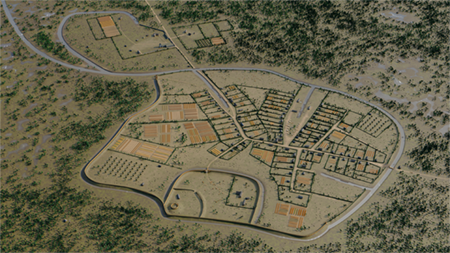
Swavesey Castle was a timber and earthwork fortification in the town of Swavesey, Cambridgeshire, probably built in the 11th or 12th century. Swavesey was an inland port, and in 1230 was acquired by the de Zouch family. They probably renovated the castle, and constructed town defences around much of the site, as part of their plans to develop the settlement. Swavesey declined in importance in the late-medieval period, and only parts of the earthworks now survive.
History
Swavesey Castle was a medieval fortification in the town of Swavesey. After the Norman conquest of 1066, Swavesey was granted to Count Alan of Brittany by William the Conqueror. Swavesey was then an island community on the edge of the Fenlands, surrounded by a stream that flowed from nearby Fen Drayton. Its name derived from Swaef’s Ey, meaning Swaef’s landing place. Swavesey had formed a large Anglo-Saxon landed estate before its transfer to Count Alan, who established a small priory on the island of dry land to the north-east, which had previously contained the manor house.
It is uncertain when the castle was constructed. It may have been built around 1070, when the Normans suppressed the rebellion at Ely, or might date from the civil war known as the Anarchy, which raged across the region in the 1140s. The castle was built on the north-west side of the settlement, overlooking a causeway into the fens, leading to the old Roman road that linked Cambridge and Huntingdon. The castle comprised an earthwork enclosure with core of gravel, approximately 200 m by 175 m (655 ft by 575 ft) across, protected by timber defences. A mound, now 3 m (10 ft) high, probably supported a defensive building in the north-west corner of the castle.
By the 12th century, Swavesey was an inland port, engaging in trade via its links to the Great Ouse. It had a dock on the east side of the town, the profits of which were granted to the priory around 1200. In 1230, Roger de Zouch acquired Swavesey. His son, Alan de Zouch, acquired the right to hold a market and fair in the town in 1244, and appears to have redeveloped the settlement around a grid plan, with the market and dock in the centre.
The region was unstable, and Alan constructed a ring of earthwork defences around it. As noted above, the castle was probably already in existence at this point, albeit possibly largely abandoned, and Alan incorporated it into his design. The defences formed a bank and ditch on the west and south, linking with the natural defences of the river that curved around the town. Swavesey was raided in 1266, during the Second Barons’ War, and some of the surrounding fields burnt by the rebel barons.
Swavesey grew in prosperity, and by 1278 its population may have reached around 1,000, making it a significant settlement. But further growth stalled and large parts of the planned town were never fully occupied. During the late-medieval period, the town’s population declined, not recovering until the 19th century. The castle itself is first mentioned in documents in 1476, although by then the defences had long since been abandoned.
In the 21st century, the remaining earthworks have been much reduced in size, both by deliberate damage over the years and because their gravel base was not robust. They are protected under UK law as a Scheduled Monument.
Bibliography
- Sayer, Duncan. (2009) “Medieval Waterways and Hydraulic Economics: Monasteries, Town and the East Anglian Fen,” World Archaeology, Volume 41, Number 1, pp. 134-150.
- Wright, A. P. M. and C. P. Lewis (eds) A History of the County of Cambridge and the Isle of Ely: Volume 9, Chesterton, Northstowe, and Papworth Hundreds. Victoria County History: London, UK.
Attribution
The text of this page is licensed under under CC BY-NC 2.0.
